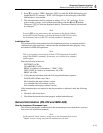
Using the Computer Interface
Using the RS-232 Computer Interface
4
4-7
Data for the oldest set of scan readings in Hydra Series II Data Logger memory can be
retrieved with the LOG? query. Each set of scan readings is cleared from memory when
read with LOG? The LOG? query returns the following information:
• Date and time at the start of the logged scan. Date and time are returned as integer
values in the same format as used with the TIME_DATE? query (hours 0-23,
minutes 0-59, seconds 0-59, month 1-12, day 1-31, year 00-99.)
• Values for the channels measured. This measurement data is returned as a list of
values in scientific notation format.
• State of the Digital I/O lines and totalize count at the time the channels were
scanned. The state of the digital I/O lines may reflect evaluation of alarms for this
set of scan measurements. Alarm outputs and digital I/O values are returned as
integer values. The Totalizer value is returned as a scientific notation value.
Data for a specific scan can be retrieved with the LOGGED? <index> query. The
<index> parameter can be 1 through 2047, signifying the number of the scan. Scan data
is not removed from memory with this query.
The number of stored scans can be retrieved with LOG_COUNT?
Memory Full Operation
If Data Logger memory is full, two methods of handling additional scan data are
available. With the LOG_MODE 0 command, older scans are written over by newer
scans on a first-in, first-out basis. Therefore, the instrument can continue to make scans
until a certain event occurs, and storage of all data leading up to the event is assured.
With the LOG_MODE 1 command, new scans are stored only when memory is
available. All data following a specific event (e.g., an alarm) can thereby be saved.
Memory can be made available in one of the following two ways:
• LOG? command clears each scan as it is read.
• Memory Clear (Front Panel or LOG_CLR) removes all scans.
The LOG_MODE setting is non-volatile and cannot be changed from the instrument
front panel.
Clearing Memory
Memory clearing is available with the Hydra Series II Data Logger (2625A) only. With
the RS-232 interface active, use the LOG_CLR command to clear all stored Data Logger
memory values. Refer to Chapter 3 for the front panel version of memory clearing.
Cabling the Instrument to a Host or Printer (RS-232)
Communications with a host are handled through a DB-9 interface connector on the rear
panel of the instrument. Pin usage is diagramed on the instrument’s rear panel and shown
in Figure 2-6.
Connect the instrument to the host (or terminal) using a cable appropriate to your
application. Usually, total cable length should not exceed 50 feet (15 meters). Longer
cables are permitted if the load capacitance measured at the interface point (including the
signal terminator) does not exceed 2500 picofarads.
To connect the instrument to an IBM PC/AT (DB-9 connector), use RS40 and RS41
cables connected in series, or use any other cable designed for interconnecting two IBM
PC/ATs. The RS40 and RS41 cables are described in Chapter 1.


















